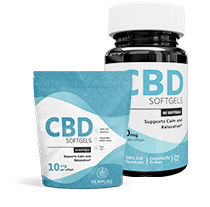Chapter
THE ENDOCANNABINOID SYSTEM, THE BODY, AND CBD
Before we understand how CBD works, we need to understand how the endocannabinoid system functions.
UNDERSTANDING THE ENDOCANNABINOID SYSTEM (ECS)
Despite humanity’s long history with the hemp plant, the discovery of cannabinoids and the ECS is relatively new to the scientific community. CBD was first isolated as a substance in Israel in 1964, and the first cannabinoid receptor was spotted in a rat brain more than twenty years later in 1988. Two years later, Lisa Matsuda and her team at The Institute of Medicine, National Academy of Sciences helped specifically identify and subsequently cloned CB receptors. This is when scientific understanding of the endocannabinoid system began to take shape. They found that endocannabinoids and the receptors they bind to exist throughout the body in the central nervous system, glands, immune cells, organs, and many different connective tissues. These findings hold the potential to revolutionize the ways in which we view health and wellness.
THE META-SYSTEM OF THE BODY
The endocannabinoid system permeates all of the other eleven unique systems in the body and helps direct their functions. For this reason, it is often described as a “meta-system” interacting with these systems while also governing them. Just as the nervous system keeps everything connected and communicating, this one system aids in regulating almost every single aspect of our wellbeing.
In each part of the body, the complex endocannabinoid system performs different tasks, but it always has the same goal in mind: homeostasis.

COMPONENTS OF THE ECS
The ECS comprises three primary components:
- Endocannabinoids
- Enzymes
- Receptors

CANNABINOIDS
Cannabinoids act as keys within the endocannabinoid system, while receptors act like locks. Every time one key fits into one lock, the lock is opened and causes an effect to occur in the body. The effect that occurs depends on the lock and where it is within the body. The two main types of cannabinoids found in the body are anandamide and 2-arachidonoylglycerol, or 2-AG.
2-AG is the most prevalent endocannabinoid and is thought to be responsible for managing appetite, pain response, and immune system functions.
Anandamide, commonly referred to as “the bliss molecule,” plays many roles related to one’s mental state and is responsible for the experience of the runner’s high, the pleasurable feeling during and after exercise, and the blissful states that come from structured play, yoga, and meditation. Early research has suggested that it also aids in apoptotic cell death (meaning it helps tell harmful cells to die off) and the regulation of memory as well.
These are some of the molecules that CBD helps supplement within our body, and aids in helping the body to produce and govern these naturally occurring cannabinoids.
ENZYMES
An enzyme is any substance within the body that causes a chemical reaction to occur or accelerates one that is already happening. Enzymes act within the ECS to recycle endocannabinoids after the body uses them. Think of them as the cleanup crew, making sure everything is put away properly after a big event. Their main purpose is to make sure that once the endocannabinoids have been used, they are broken down and not available for longer than intended. Without enzymes to help regulate the use of cannabinoids, the ECS would not be able to reach homeostasis.
The two main enzymes in the endocannabinoid system are fatty acid amide hydrolase (FAAH) and monoacylglycerol lipase (MAGL). FAAH breaks down anandamide and MAGL breaks down 2-AG, keeping the two substances in balance within the body.
RECEPTORS
CB1 receptors exist in the brain and spinal cord. They work to regulate appetite, memory, and to reduce pain.
CB2 receptors are most prominently present within the immune system, but exist through many other areas of the body, including the gut, spleen, liver, heart, kidneys, bones, blood vessels, lymph cells, endocrine glands, and reproductive organs. CB2 receptors are also plentiful on the skin which allows topicals to influence the ECS. CB2 receptor primary role is reducing inflammation throughout the body.

In  Flam
Flam  ma
ma  tion
tion
Inflammation is a process the body undergoes to heal infected or damaged areas in the body. Inflammation is one of the main causes of many different medical conditions.
the 11 systems of the body and how the ecs relates to it
NERVOUS SYSTEM & THE ECS
The nervous system is comprised of the brain, the spinal cord, and all the nerves throughout the body. Its main job is to coordinate various actions that occur throughout the body.
By registering sensations and stimuli, nerves relay information back to the brain so it can decide if and how to react. Further, the nervous system controls autonomic functions like breathing, heart rate, and digestion. Beyond these basic functions, it is also responsible for our higher faculties, like deduction and reasoning. The experience of stimulation and the retention of memory are also impacted by the nervous system.
The two extremes of the nervous system are overstimulation or exhaustion. The ECS works to ensure that the nervous system does not stray too far toward one of these polar extremes. Ideally, it helps you stay in an alert but calm state, ready to take on the challenges and stimulation of everyday life.
GABA AND GLUTAMATE
Gaba is like the brakes in your car. When brakes are functioning, your car operates well. It can stop when it needs to and slow down as it should, in smooth transition. When there is too much GABA, it is like driving with the emergency brake on all the time. You’ll feel tired, sluggish, and slow, unable to move forward and think as you should.
When levels of GABA are too low, you have a more difficult time relaxing and calming down, leading to feeling nervous, anxious, susceptible to panic attacks, aggressive, and less interested in social behavior.
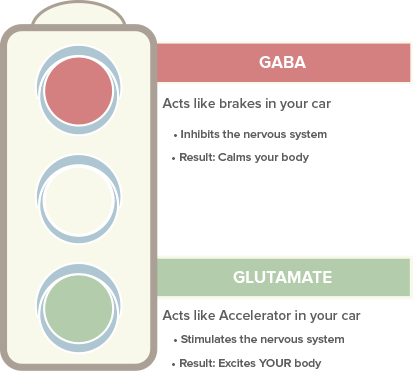

WHAT HAPPENS WHEN YOU HAVE TOO MUCH GLUTAMATE?
When you have too much glutamate, it’s like speeding. You’ll feel rushed, anxious, and things may feel out of control.
Some of the potential conditions that result from an extreme excess of glutamate include Autism, ALS, Parkinson’s, schizophrenia, migraines, restless leg syndrome, Tourette’s, fibromyalgia, multiple sclerosis, and epilepsy.1,2 High levels of glutamate may also result in increasing the number of unfavorable bacteria in the gut.
GABA and glutamate are complementary. When you have too much of one, you have too little of the other. In an optimal state of well being, there is a balanced mixture of both. That’s where the endocannabinoid system comes into play.
The ECS works to make sure that levels of GABA and glutamate remain in balance.
HOW DOES THE ECS
ACCOMPLISH THIS?
Brain cells work together by transmitting chemical signals as messages to each other. The messages these cells send help to all parts of our body to coordinate the multitude of functions necessary to survive. Neurons release neurotransmitters from a presynaptic cell that travels across a small gap to the postsynaptic cell. From the postsynaptic cell, the neurotransmitter binds to a receptor.
When the binding occurs, this causes a reaction that allows the message to continue forward. Imagine this scenario like sending a telegram. The sender sends the message and it comes out as a direction on the other side. Whoever receives the message will take the instruction and act, but cannot respond.
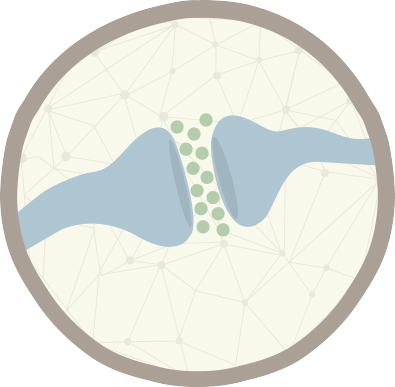
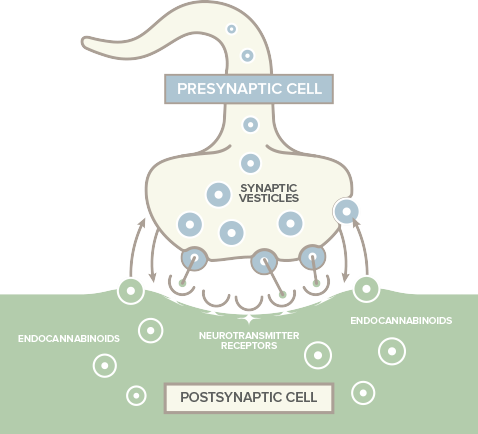
THE ENDOCANNABINOID SYSTEM WORKS A BIT DIFFERENTLY.
The ECS works backward and sends its message from the postsynaptic cell to the presynaptic cell. When cannabinoids are needed, they are made in the postsynaptic neuron and sent to the presynaptic neuron. This feedback loop helps maintain balance in the nervous system.
Essentially, the ECS has a telephone in our imagined scenario and can call ahead to tell the telegraph sender.
Why is this important? The cannabinoids that are released can act like a brake on the release of neurotransmitters. When either GABA or glutamate is being released too rapidly from the presynaptic neuron, cannabinoids are released from the postsynaptic neuron to slow down their production. Having properly called for supplies, the telegraph receiver can then optimally put them to use.
The endocannabinoid system performs a delicate balancing atct within the nervous system to make sure that you’re moving neither too slow or too fast. A healthy endocannabinoid system leads to a healthy mental state, a great state of mind, and a quality physical life.
CBD AND THE NERVOUS SYSTEM
CBD has shown properties of being a neuroprotectant, helping with the creation of neuron cells as well as fortifying their structures against degeneration. Though this is primarily an interaction of the ECS and the immune system, CBD has been shown to help to support neurological function in preliminary tests in studies with rates while testing the blood-retinal barrier-preserving effects of cannabidiol in experimental diabetes.3
CARDIOVASCULAR SYSTEM & THE ECS
Current research shows that the endocannabinoid system plays an important role in controlling heart rate and blood pressure.4

CANNABINOID RECEPTORS ARE PRESENT IN THE MUSCLE TISSUE OF THE HEART.
They exhibit a number of effects that lead to a reduction in blood pressure. These receptors can cause vasodilation to occur. Vasodilation is the process of blood vessels dilating, which results in a decrease in blood pressure. They can also weaken the force of heart contractions, which can lead to a reduction in blood pressure.5
THE GUT AND THE
ENDOCANNABINOID SYSTEM
Endocannabinoid receptors exist throughout the gut and digestive system.
The ECS plays a role in mediating hunger and the desire to eat. As a result, different cannabinoids can either stimulate hunger (CBD and THC) or suppress it (THCV).
The ECS also helps regulate metabolism6, the rate and efficiency at which the body breaks down calories for use in the body and gut motility7, and the rate that things move through your digestive tract. With a properly functioning ECS, the gut can uptake food more easily and efficiently, and better deal with irritants.
As previously mentioned, CBD and the ECS can play a large role in supporting control over the inflammatory response.
We already know that ECS plays an integral role in our digestive system in relation to calories and comfort, but it may play a greater part than previously thought.

EMERGING RESEARCH SHOWS THAT THE GUT ALSO MODULATES MENTAL HEALTH.8
Has an upsetting thought ever caused you to become nauseated? Outside of the brain, your gut contains the highest concentration of neurons in the body. These neurons are linked to your spinal cord, and this is one of the many reasons that feelings can influence the feeling in our gut and vice versa.
Recent science shows that there may be a critical link between the microbiome (the unique colony of beneficial bacteria living inside the gut), mental states, and the endocannabinoid system. These connections continue to fascinate and intrigue much of the medical community.
IMPROVE YOUR GUT, IMPROVE YOUR ENDOCANNABINOIDS
Studies show that the endocannabinoid system and the gut microbiome interlink. By taking a specific probiotic, rats saw an increase in the number of endocannabinoids present in their gut.
The same study suggests that an increase in endocannabinoids may decrease abdominal pain.9 Multiple studies have shown a link between anxiety and depression to gut biome, and that a biome associated with good mental health can be transplanted to others to increase their mental health, showing a causal relationship.10 While the direct mechanisms of this interplay are still emerging, there is evidence to support that by improving the gut-barrier function, using both the microbiome and the endocannabinoid system, it is possible to improve the metabolism of fat tissue, mental health, and the inflammation response within the gut.

ENDOCRINE SYSTEM & THE ECS
The endocrine system does all that and more, and the endocannabinoid system makes sure it functions at its best.
The endocrine system is a collection of glands and organs responsible for regulating and controlling the hormones present in the body. Hormones aid in controlling many different bodily functions including growth, the repair of cells, reproduction, metabolism, sexual development, mood, and sexual function.
The endocannabinoid system is an essential part of maintaining the endocrine system by regulating the balance of energy and hunger.
The ECS also plays a role in many common endocrine disorders including hyperthyroidism, hypothyroidism, diabetes, and other problems that take place in the endocrine system. When the ECS gets over or under stimulated, many of these diseases can occur.

The endocannabinoid system modulates various endocrine functions in the brain. The endocannabinoids themselves play a role in creating both oxytocin and vasopressin, two hormones essential to the way the endocrine system functions in the brain.11
Multiple studies show that the ECS alters and changes the secretion of hormones and the processes involved in metabolism. The ECS also regulates some of the reproductive functions and stress responses. High or low levels of endocannabinoids alter the endocrine system and hinder functionality.12
IMMUNE SYSTEM
Healthy immune function starts with a properly balanced endocannabinoid system. The ECS is intertwined through the immune system and plays a pivotal role in ensuring that you stay free from infection and autoimmune disorders.
Immune cells have cannabinoid receptors, produce cannabinoids, and have a mechanism for breaking down cannabinoids after they’ve been used. The main role that the endocannabinoid system plays in the immune system is establishing immune homeostasis.13

the ENDOCANNABINOID system works to establish immune system homeostasis
The Immune system is in homeostasis when it is neither too active or inactive.
WHEN THE IMMUNE SYSTEM IS TOO ACTIVE
It attacks the body's own cells, causing the body to wreak havoc on itself which can result in major health concerns.
WHEN THE IMMUNE SYSTEM IS NOT ACTIVE ENOUGH
Your body’s ability to fight off infections and viruses is weakened and you get sick.
BALANCING THE IMMUNE SYSTEM
A balanced immune system is neither too active or inactive. When your immune system becomes too active, it can attack the body’s own cells resulting in autoimmune diseases. When it is not active enough, you become susceptible to bacteria and viruses. The immune system maintains a sweet spot in the middle of these two poles by actively fighting invading foreign agents that can cause harm, eliminating damaged cells and not attacking cells that function properly. The healthy elimination of damaged cells is one of the primary roles of the immune system and is specifically supported by CBD. This is also one of the primary functions that CBD does for the hemp plant, and why it works so well to do the same in our bodies..
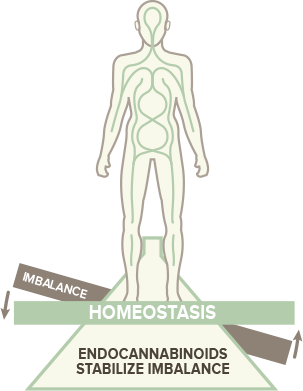
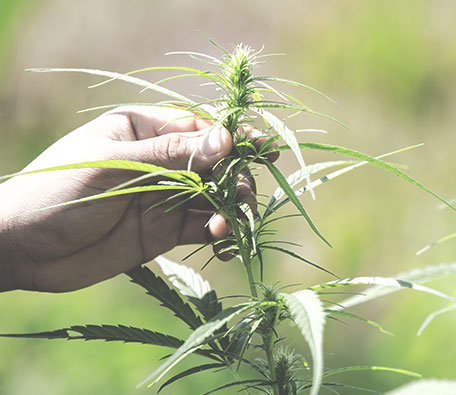
The healthy elimination of damaged cells is one of the primary roles of the immune system, and is specifically supported by CBD. this is also one of the primary functiona that cbd does for the hemp plant, and why it works so well ro do the same in our bodies.
Another main function of the immune system is balancing the inflammatory response. Most autoimmune diseases result from this imbalance.
The endocannabinoid system’s role within the immune system is to help it get to this point of balance. Let’s take a look at what happens when the immune system gets out of balance so you can understand how essential the endocannabinoid system is to create a state of optimal health.
TOO INACTIVE IMMUNE RESPONSE ISSUES
Your immune system can be too inactive. The result is many different maladies. Cancer is a perfect example.
Everyone has cancer cells in their bodies at all times. You have cancer cells in your body right now. When the immune system acts as it should, it notices these cancer cells before they proliferate and pose a threat to your health. It disposes of them and you go on feeling healthy.
The immune system is the body’s main defense system against foreign invaders and infectious diseases. It fights infection and ensures cells in the body are operating in a healthy and proper way.
Throughout day to day to life, you come into contact with enormous numbers of bacteria, viruses, and parasites that try to infiltrate your body. If you didn’t have an immune system, these bacteria would cause distress and sickness. When your immune system is working well, it attacks bacteria and viruses and prevents you from getting sick. If the immune system is not active enough, these bacteria and viruses can proliferate and cause sickness.
The endocannabinoid system makes sure your immune system does not become too inactive. It is able to fight off invaders and also eliminate any diseased or cancerous cells.
TOO ACTIVE IMMUNE RESPONSE ISSUES
Many of the most prevalent diseases are a result of an immune system becoming too active. The immune system should attack its own cells if they become infected with a pathogen or become cancerous. The immune system patrols around the body seeking these damaged cells and eliminating the ones it finds to be sick. In some cases, the immune system goes rogue and starts to attack healthy cells.
One example of this phenomenon is multiple sclerosis. In multiple sclerosis, the body’s immune system attacks its own healthy cells. The body’s immune system gets confused about which cells are healthy and which are sick. It attacks many of the healthy ones resulting in horrible symptoms and responses.
Something similar occurs in type 1 diabetes. The immune system attacks pancreatic cells causing the pancreas to produce little to no insulin.
Allergies are another condition that comes on as a result of an overactive immune system. The immune system notices pollen and mistakes it for an attacking pathogen. It then creates an immune response that is designed to eliminate the pollen as though it were bacteria.
Now that you have a better of what the immune system begins to look like when it gets out of balance, let’s take a look at how the endocannabinoid system creates homeostasis in the immune system.
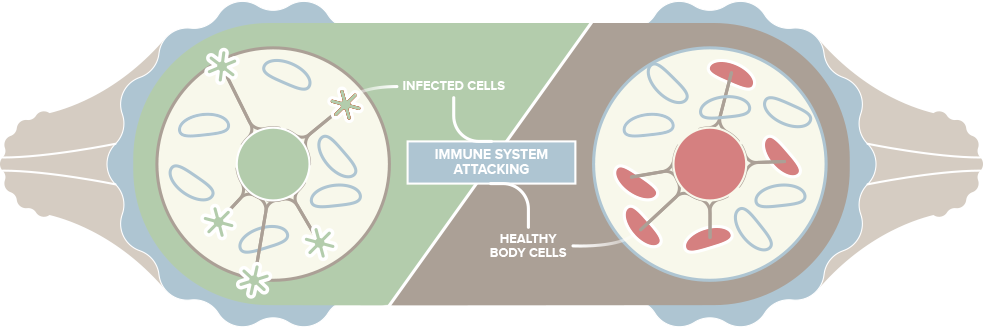
HOW THE ECS BALANCES THE IMMUNE SYSTEM
How the endocannabinoid system balances the immune system is a vast topic that comprises the different cells of the immune system and the ways in which they function.
Both CB1 and CB2 receptors have a role in regulating the activity of a certain type of protein that is involved in the regulation of lymphocytes. Lymphocytes are a type of white blood cell. This regulation is an important part of keeping the entire immune system in homeostasis.
The stimulation of cannabinoid receptors within the immune system causes a series of regulations and modulations to take place along cAMP pathways. These pathways are responsible for many different types of communications that take place throughout the immune system. They are thought to play a significant role in the regulation and creation of immune homeostasis.14

The ways in which the endocannabinoid system and immune system function together have not been fully defind at the moment. It appears that the cannabinoid receptors in the immune system exhibit varying responses. One of the main roles that the endocannabinoid system appears tp play in the immune system in signaling for the inhibition in activity across different types of cells which prevents the immune system from being activated when it should not be. However, while the ECS can inhibit activity, it has a certain threshold that can be overcome if the threat to the body is severe enough. This allows the immune system to respond when a serious threat like an infection occurs. The endocannabinoid receptors in the immune system can exhibit two different types of effects: stimulation or suppression.
With the combination of both stimulatory and inhibitory potentials, the endocannabinoid system allows for the establishment of homeostasis by preventing the immune system from becoming overly active or not active enough.
SKELETAL SYSTEM
Cannabinoid receptors help our bodies determine peak bone mass and respond to bone damage by telling the body to create new skeletal cells to replace them. The ECS ensures our bones are strong enough to transport us and withstand impact.
When the body is unable to sustain optimal bone density, this is the cause of osteoporosis. On the opposite side of the spectrum, there are a host of hyperostosis, or bone overgrowth, disorders. A balanced ECS can help maintain optimal bone health, which will naturally degrade as we age.
A 2009 study determined that The CB1 receptor may support regulating peak bone mass 15, and that applying CBD may help support the cartilage that mends fractures after a break.
Conclusion
- The numerous and complex ways in which the endocannabinoid system exist and functions within the body hold tremedous potential for new discoveries in health and medicine.
- Now that you have an understanding of how these systems intermingle together, it’s time to learn about some of the ways that the endocannabinoid system can be boosted and supported naturally.
Summary
- The stronger your body’s ability to reach homeostasis, the healthier you are.
- The endocannabinoid system consists of enzymes, receptors, and endocannabinoids.
- The endocannabinoid system supports a healthy nervous system, immune system, and more.
- When the endocannabinoid system gets out of balance, all aspects of your health can suffer.
-
10
REFERENCES
- Jan Lewerenz, Pamela Maher, Chronic Glutamate Toxicity in Neurodegenerative Disease — What is the Evidence?, Frontiers in Neuroscience, 2015 Dec 16, https://www.ncbi.nlm.nih.gov/pmc/articles/PMC4679930/
- Stephanie Liou, About Glutamate Toxicity, Huntington’s Outreach Project for Education, 2011 Jun 26, http://web.stanford.edu/group/hopes/cgi-bin/hopes_test/about-glutamate-toxicity/
- Azza B. El-Remessy, Mohamed Al-Shabrawey, Yousef Khalifa, Nai Tse-Tsai, Ruth B. Caldwell, Gregory Liou, Neuroprotective and Blood-Retinal Barrier-Preserving Effects of Cannabidiol In Experimental Diabetes, The American Journal of Pathology, 2006 Jan, https://www.sciencedirect.com/science/article/pii/S000294401062086X
- Pal Pacher, Sandor Batkai, George Kunos, Blood Pressure Regulation by Endocannabinoids and Their Receptors, Neuropharmacology, 2005 Jun, https://www.ncbi.nlm.nih.gov/pmc/articles/PMC2225528/
- Engeli S, Dysregulation of The Endocannabinoid System in Obesity, Journal Neuroendocrinal, 2008 May, https://www.ncbi.nlm.nih.gov/pubmed/18426509
- Kim J., Li Y, Watkins BA, Endocannabinoid Signalling and Energy Metabolism: A Target For Dietary Intervention, Nutrition, 2011 Jun, https://www.ncbi.nlm.nih.gov/pubmed/21470818
- Nicholas V. DiPatrizio, Endocannabinoids in The Gut, Cannabis and Cannabinoid Research, 2016 Feb,https://www.ncbi.nlm.nih.gov/pmc/articles/PMC4940133/#s002title
- Emeran A. Meyer, Rob Knight, Sarkis Mazmanian, John Cryan, Kristin Tillich, Gut Microbes and The Brain: Paradigm Shift in Neuroscience, Journal of Neuroscience, 2014 Nov, http://www.jneurosci.org/content/34/46/15490.short
- Rousseaux C, Thuru X, Gelot A, Barnich N, Neut C, Dubuqouy L, Merour E, Geboes K, Chamaillard M, Ouwehand A, Leyer G, Carcano D, Colombel JF, Ardid D, Desreumax P, Lactobacillus Acidophilus Modulates Intestinal Pain and Induces Opiod and Cannabinoid Receptors, Nat Med., 2007 Jan, https://www.ncbi.nlm.nih.gov/pubmed/17159985
- Stephen Collins, Premsyl Bercik, Instestinal Bacteria Influence Brain Acitivity in Healthy Humans, Nature Reviews Gastroenterology and Hepatology, 2013 May, https://www.nature.com/articles/nrgastro.2013.76
- De Laurentiis A, Fernandez Solari J, Mohn C, Zorilla Zubilete M, Retorri V, Endocannabinoid System Participates in Neuroendocrine Control of Homeostasis, Neuroimmunomodulation, 2010, https://www.ncbi.nlm.nih.gov/pubmed/20134190
- Kat Merryfield, CBD and Endocrine Disorders, Kat’s Naturals, https://katsnaturals.com/cbd-and-endocrine-disorders/
- Rupal Pandey, Khalida Mousauwy, Mitzi Nagarkatti, Prakash Nagarkatti, Endocannabinoids and Immune Regulation, Pharmacol Res., 2009 Aug, https://www.ncbi.nlm.nih.gov/pmc/articles/PMC3044336/
- National Cancer Institute, NCI Dictionary of Cancer Terms, https://www.cancer.gov/publications/dictionaries/cancer-terms/def/cancer
- Rupal Pandey, Khalida Mousauwy, Mitzi Nagarkatti, Prakash Nagarkatti, Endocannabinoids and Immune Regulation, Pharmacol Res., 2009 Aug, https://www.ncbi.nlm.nih.gov/pmc/articles/PMC3044336/





